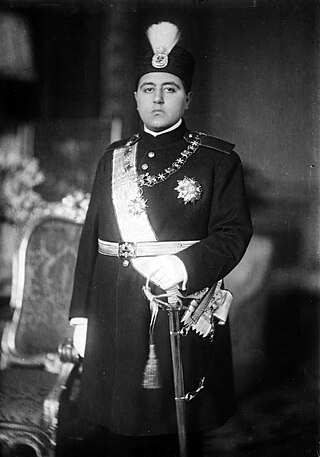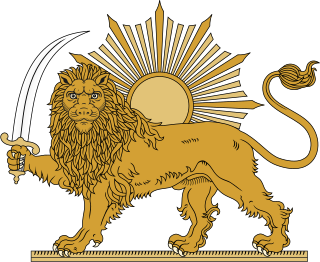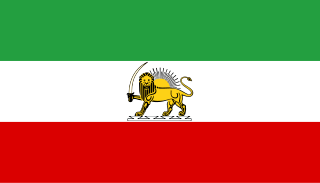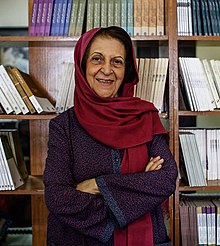
Reza Shah Pahlavi was an Iranian military officer, politician, and first shah of the House of Pahlavi of the Imperial State of Iran and father of the last shah of Iran. He reigned from 15 December 1925 until he was forced to abdicate by the Anglo-Soviet invasion of Iran on 16 September 1941. Reza Shah introduced many social, economic, and political reforms during his reign, ultimately laying the foundation of the modern Iranian state. Therefore, he is regarded as the founder of modern Iran.

Masjed Soleyman is a city and capital of Masjed Soleyman County, Khuzestan Province, Iran. At the 2006 census, its population was 206,121, in 51,530 families.

The Qajar dynasty was an Iranian royal dynasty of Turkic origin, specifically from the Qajar tribe, ruling over Iran from 1789 to 1925. The Qajar family took full control of Iran in 1794, deposing Lotf 'Ali Khan, the last Shah of the Zand dynasty, and re-asserted Iranian sovereignty over large parts of the Caucasus. In 1796, Mohammad Khan Qajar seized Mashhad with ease, putting an end to the Afsharid dynasty, and Mohammad Khan was formally crowned as Shah after his punitive campaign against Iran's Georgian subjects. In the Caucasus, the Qajar dynasty permanently lost many of Iran's integral areas to the Russians over the course of the 19th century, comprising modern-day eastern Georgia, Dagestan, Azerbaijan and Armenia.

Ahmad Shah Qajar was Shah of Persia (Iran) from 16 July 1909 to 15 December 1925, and the last ruling member of the Qajar dynasty.

Mohammad Ali Shah Qajar, Shah of Iran from 8 January 1907 to 16 July 1909. He was the sixth shah of the Qajar Dynasty.

Mozaffar ad-Din Shah Qajar, was the fifth shah of Qajar Iran, reigning from 1896 until his death in 1907. He is often credited with the creation of the Persian Constitution of 1906, which he approved of as one of his final actions as Shah.

The Prime Minister of Iran was a political post that had existed in Iran (Persia) during much of the 20th century. It began in 1906 during the Qajar dynasty and into the start of the Pahlavi dynasty in 1923 and into the 1979 Iranian Revolution before being abolished in 1989.
Iranian-Armenians, also known as Persian-Armenians, are Iranians of Armenian ethnicity who may speak Armenian as their first language. Estimates of their number in Iran range from 70,000 to 200,000. Areas with a high concentration of them include Tabriz, Tehran, Salmas and Isfahan's Jolfa quarter.
The military history of Iran has been relatively well-documented, with thousands of years' worth of recorded history. Largely credited to its historically unchanged geographical and geopolitical condition, the modern-day Islamic Republic of Iran has had a long and checkered military culture and history; ranging from triumphant and unchallenged ancient military supremacy, affording effective superpower status for its time; to a series of near-catastrophic defeats at the hands of previously subdued and conquered peripheral nations, most notably including the ancient Greek kingdom of Macedon as well as the Asiatic nomadic tribes at the northeastern boundary of the lands traditionally home to the Iranian peoples.

Iranian nationalism refers to nationalism among the people of Iran and individuals whose national identity is Iranian. Iranian nationalism consists of political and social movements and sentiments prompted by a love for Iranian culture, Iranian languages and history, and a sense of pride in Iran and Iranian people. Whilst national consciousness in Iran can be traced back for centuries, nationalism has been a predominant determinant of Iranian attitudes mainly since the 20th century. Modern Iranian nationalism rose during the constitutional revolution. There began a refreshing atmosphere of unity and Iranian patriotic sentiments during the constitutional era. During the Pahlavi dynasty (1925–1979), Iranian nationalism experienced a resurgence due to the Pahlavi government's bolstering of patriotic sentiment.

The Lion and Sun is one of the main emblems of Iran (Persia), and was an element in Iran's national flag until the 1979 Iranian Revolution and is still commonly used by opposition groups of the Islamic Republic government. The motif, which illustrates ancient and modern Iranian traditions, became a popular symbol in Iran in the 12th century. The lion and sun symbol is based largely on astronomical and astrological configurations: the ancient sign of the sun in the house of Leo, which itself is traced back to Babylonian astrology and Near Eastern traditions.

The Persian Constitutional Revolution, also known as the Constitutional Revolution of Iran, took place between 1905 and 1911 during the Qajar dynasty. The revolution led to the establishment of a parliament in Persia (Iran), and has been called an "epoch-making episode in the modern history of Persia".
The following is a timeline of the history of the city of Tehran, Iran.

The Imperial State of Iran, also known as the Imperial State of Persia, was the official name of the Iranian state under the rule of the Pahlavi dynasty.

Pedram Khosronejad is a socio-cultural and visual anthropologist of contemporary Iran. He is of Iranian origin and commenced his studies in Painting and in Visual Art Research before moving to France with a Ph.D. grant in 2000. He obtained his D.E.A. at Ecole Pratique des Hautes Etudes and obtained his Ph.D. at the École des Hautes Études en Sciences Sociales (Paris). His research interests include cultural and social anthropology, the anthropology of death and dying, visual anthropology, visual piety, holy artifacts, and religious material culture, with a particular interest in Iran, Persianate societies and the Islamic world.

Qajar Iran, also referred to as Qajar Persia, the Qajar Empire, Sublime State of Persia, officially the Sublime State of Iran and also known as the Guarded Domains of Iran, was an Iranian state ruled by the Qajar dynasty, which was of Turkic origin, specifically from the Qajar tribe, from 1789 to 1925. The Qajar family took full control of Iran in 1794, deposing Lotf 'Ali Khan, the last Shah of the Zand dynasty, and re-asserted Iranian sovereignty over large parts of the Caucasus. In 1796, Agha Mohammad Khan Qajar seized Mashhad with ease, putting an end to the Afsharid dynasty. He was formally crowned as Shah after his punitive campaign against Iran's Georgian subjects.
Iranian Russians or Persian Russians are Iranians in the Russian Federation, and are Russian citizens or permanent residents of (partial) Iranian national background.

Abbas Amanat is an Iranian-born American historian, scholar, author, editor, and professor. He serves as the William Graham Sumner Professor of History at Yale University and Director of the Yale Program in Iranian Studies.
The Iranian women participated actively in constitutional, struggles. From the year 1906 women's organizations were formed and many women participated in constitutionalism. But the National Women's Movement was just a minority movement and part of the great national movement of Iran with the goal of the independence of the country and the implementation of the constitution. The participation of women in these political events was spontaneous, with their new nationalist sentiment and willingness to be recognized.
Willem Marius Floor is a Dutch historian, writer, and Iranologist. He was born in 1942 in Utrecht, the Netherlands. After finishing high school, he attended the University of Utrecht where he studied economics, non-Western sociology, and Islamic studies. He also studied Arabic and eventually became interested in Persian. He received his PhD from the University of Leiden in 1971. The title of his PhD dissertation was "The Guilds In Qajar Persia." Ever since, he has been engaged in Iranian studies. Throughout this time, he has published extensively on the socio-economic history of Iran. As an independent scholar, Willem Floor has published numerous works of history as well as translations. Dr. Floor is also a winner of Farabi International Prize for Humanitarian Studies.













